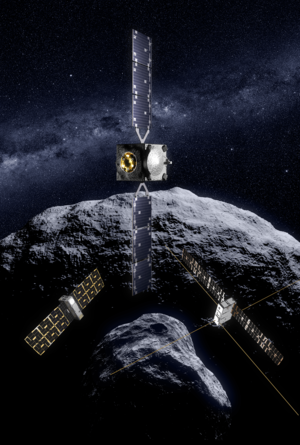Accept all cookies Accept only essential cookies See our Cookie Notice

About ESA
The European Space Agency (ESA) is Europe’s gateway to space. Its mission is to shape the development of Europe’s space capability and ensure that investment in space continues to deliver benefits to the citizens of Europe and the world.
Highlights
ESA - United space in Europe
This is ESA ESA facts Member States & Cooperating States Funding Director General Top management For Member State Delegations European vision European Space Policy ESA & EU Space Councils Responsibility & Sustainability Annual Report Calendar of meetings Corporate newsEstablishments & sites
ESA Headquarters ESA ESTEC ESA ESOC ESA ESRIN ESA EAC ESA ESAC Europe's Spaceport ESA ESEC ESA ECSAT Brussels Office Washington OfficeWorking with ESA
Business with ESA ESA Commercialisation Gateway Law at ESA Careers Cyber resilience at ESA IT at ESA Newsroom Partnerships Merchandising Licence Education Open Space Innovation Platform Integrity and Reporting Administrative Tribunal Health and SafetyMore about ESA
History ESA Historical Archives Exhibitions Publications Art & Culture ESA Merchandise Kids Diversity ESA Brand Centre ESA ChampionsSpace in Member States
Find out more about space activities in our 23 Member States, and understand how ESA works together with their national agencies, institutions and organisations.
Science & Exploration
Exploring our Solar System and unlocking the secrets of the Universe
Go to topicAstronauts
Missions
Juice Euclid Webb Solar Orbiter BepiColombo Gaia ExoMars Cheops Exoplanet missions More missionsActivities
International Space Station Orion service module Gateway Concordia Caves & Pangaea BenefitsLatest
Space Safety
Protecting life and infrastructure on Earth and in orbit
Go to topicAsteroids
Asteroids and Planetary Defence Asteroid danger explained Flyeye telescope: asteroid detection Hera mission: asteroid deflection Near-Earth Object Coordination CentreSpace junk
About space debris Space debris by the numbers Space Environment Report In space refuelling, refurbishing and removingSafety from space
Clean Space ecodesign Zero Debris Technologies Space for Earth Supporting Sustainable DevelopmentApplications
Using space to benefit citizens and meet future challenges on Earth
Go to topicObserving the Earth
Observing the Earth Future EO Copernicus Meteorology Space for our climate Satellite missionsCommercialisation
ESA Commercialisation Gateway Open Space Innovation Platform Business Incubation ESA Space SolutionsLatest
Enabling & Support
Making space accessible and developing the technologies for the future
Go to topicBuilding missions
Space Engineering and Technology Test centre Laboratories Concurrent Design Facility Preparing for the future Shaping the Future Discovery and Preparation Advanced Concepts TeamSpace transportation
Space Transportation Ariane Vega Space Rider Future space transportation Boost! Europe's Spaceport Launches from Europe's Spaceport from 2012Latest

Mini-radar for asteroid CubeSat
Thank you for liking
You have already liked this page, you can only like it once!
This 10-cm box will make history as the smallest radar instrument to be flown in space – and the very first radar to probe the interior of an asteroid. Its target? The Dimorphos asteroid, which on the night of 26 September had its orbit diverted and a vast 10 000 km plume sent out into space by collision with NASA’s DART mission.
This radar instrument, connected to a quartet of 1.5 m-long antenna booms, will be flown aboard the aircraft-carry-on-sized Juventas CubeSat, which will in turn be flown to Dimorphos aboard ESA’s Hera spacecraft, due to be launched in two years’ time.
Hera – currently taking shape at OHB in Germany and Avio in Italy – will fly to Dimorphos to perform a close-up survey of the aftermath of the DART impact, gathering key information such as the size of DART’s crater, the mass of Dimorphos as well as its make-up and internal structure. Hera’s extra data will help turn the DART deflection experiment into a well-understood, repeatable technique that might one day be needed for real.
And in fact, Hera is not one spacecraft but three: it carries with it ESA's first deep-space CubeSats to make extra observations of its asteroid target. The radar-hosting Juventas will be accompanied by Milani, which will survey the composition of Dimorphos’s surface and dust.
This ‘JuRa’ instrument is a miniaturised version of the radar flown aboard ESA’s Rosetta comet mission and used to probe beneath the black surface of comet 67P/Churyumov–Gerasimenko. It was developed by Dr. Alain Hérique’s group at the Institut de Planétologie et d'Astrophysique de Grenoble (IPAG) at the Université Grenoble Alpes and Dr Dirk Plettemeier’s group at Technical University Dresden, together with Emtronix in Luxembourg responsible for manufacturing the instrument.
-
CREDIT
JuRA Team / UGA -
LICENCE
ESA Standard Licence

JuRA radar packaging

Testing mini-radar to peer inside asteroid

Hera scans Dimorphos

Hera CubeSats’ touchdown















 Germany
Germany
 Austria
Austria
 Belgium
Belgium
 Denmark
Denmark
 Spain
Spain
 Estonia
Estonia
 Finland
Finland
 France
France
 Greece
Greece
 Hungary
Hungary
 Ireland
Ireland
 Italy
Italy
 Luxembourg
Luxembourg
 Norway
Norway
 The Netherlands
The Netherlands
 Poland
Poland
 Portugal
Portugal
 Czechia
Czechia
 Romania
Romania
 United Kingdom
United Kingdom
 Slovenia
Slovenia
 Sweden
Sweden
 Switzerland
Switzerland
























